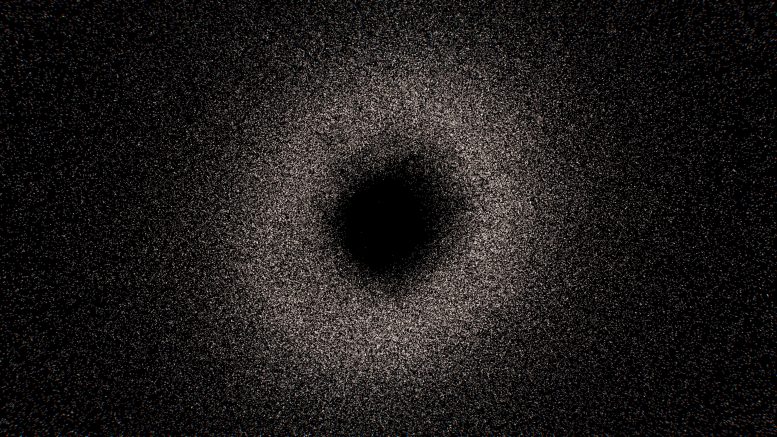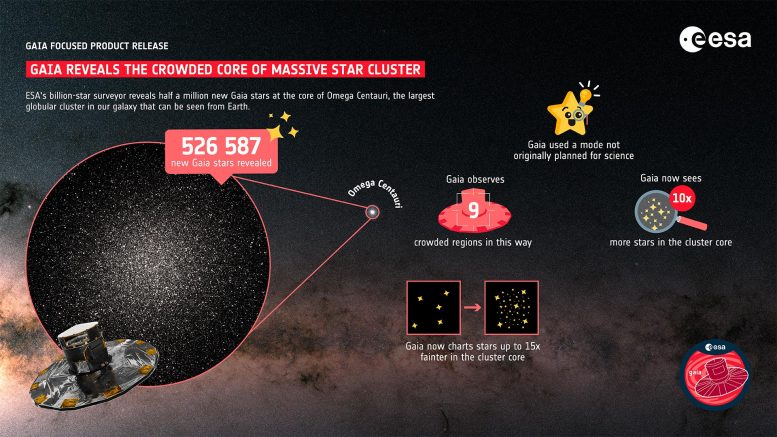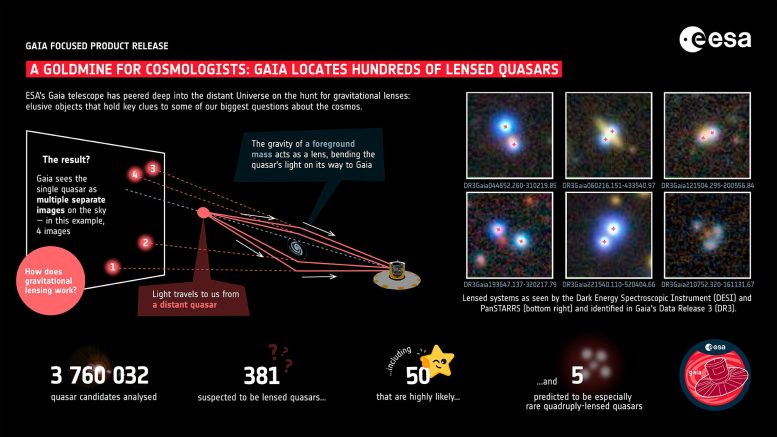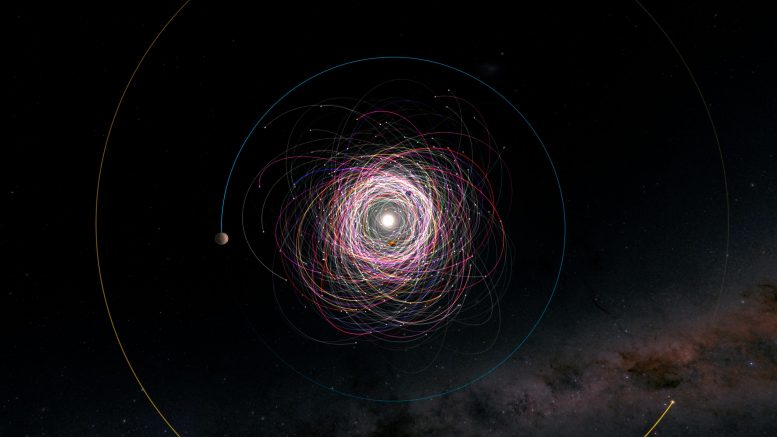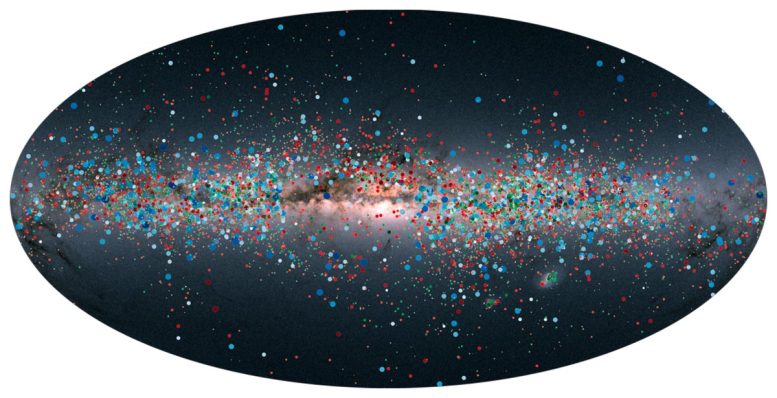ESA’s star-surveying Gaia mission has released a treasure trove of new data as part of its ‘focused product release’. As part of this data release, Gaia explored Omega Centauri, the largest globular cluster that can be seen from Earth and a great example of a ‘typical’ cluster.
The team has revealed 526,587 stars that Gaia had not seen before, detecting stars that lie too close together to be measured in the telescope’s regular pipeline and those in the cluster core that are up to 15 times fainter than previously seen. The new data reveal 10 times more stars in Omega Centauri; this new knowledge will enable researchers to study the cluster’s structure, how the constituent stars are distributed, how they’re moving, and more.
Credit: ESA/Gaia/DPAC, CC BY-SA 3.0 IGO, Acknowledgments: Toni Sagristà, Stefan Jordan, Katja Weingrill, Alexey Mints, Tineke Roegiers
This image is from Gaia’s Data Release 3 in 2022. The image above is from the new data release, and shows just how many new sources have been imaged in the cluster’s center. Only faint stars within Omega Centauri are plotted in both images.
Credit: ESA/Gaia/DPAC, CC BY-SA 3.0 IGO, Acknowledgments: Michele Trabucchi, Nami Mowlavi and Thomas Lebzelter
ESA’s Gaia mission has discovered over half a million new stars, pinpointed 150,000 asteroids, and identified 380 cosmic lenses. These findings advance our understanding of the universe, setting the stage for the anticipated Gaia DR4 release in 2025.
Recently, ESA’s Gaia mission released a goldmine of knowledge about our galaxy and beyond. Among other findings, the star surveyor surpasses its planned potential to reveal half a million new and faint stars in a massive cluster, identify over 380 possible cosmic lenses, and pinpoint the positions of more than 150,000 asteroids within the Solar System.
Gaia is mapping our galaxy and beyond in extraordinary multi-dimensional detail, completing the most accurate stellar census ever. The mission is painting a detailed picture of our place in the Universe, enabling us to better understand the diverse objects within it.
The mission’s latest ‘focused product release’ builds further on this, providing many new and improved insights into the space around us. The release brings exciting and unexpected science: findings that go far beyond what Gaia was initially designed to discover and dig deep into our cosmic history.
So – what’s new from Gaia?
Mapping the Uncharted: New Star Discoveries
Gaia’s third data release (DR3) contained data on over 1.8 billion stars, building a pretty complete view of the Milky Way and beyond. However, there remained gaps in our mapping. Gaia had not yet fully explored areas of sky that were especially densely packed with stars, leaving these comparatively unexplored – and overlooking stars shining less brightly than their many neighbors.
Globular clusters are a key example of this. These clusters are some of the oldest objects in the Universe, making them especially valuable to scientists looking at our cosmic past. Unfortunately, their bright cores, chock-full of stars, can overwhelm telescopes attempting to get a clear view. As such, they remain missing jigsaw pieces in our maps of the Universe.
To patch the gaps in our maps, Gaia selected Omega Centauri, the largest globular cluster that can be seen from Earth and a great example of a ‘typical’ cluster. Rather than just focusing on individual stars as it typically would, Gaia enabled a special mode to truly map a wider patch of sky surrounding the cluster’s core every time the cluster came into view.
The team revealed 526,587 new Gaia stars from this cluster alone, detecting stars that lie too close together to be measured in the telescope’s regular pipeline and those in the cluster core that are up to 15 times fainter than previously seen. The new data reveal 10 times more stars in Omega Centauri; this new knowledge will enable researchers to study the cluster’s structure, how the constituent stars are distributed, how they’re moving, and more, creating a complete large-scale map of Omega Centauri.
Credit: ESA/Gaia/DPAC, CC BY-SA 3.0 IGO, Acknowledgments: Based on the paper “Gaia Focused Product Release: Sources from Service Interface Function Image Analysis – Half a Million New Sources in Omega Centauri” by Gaia Collaboration, K. Weingrill et al.; Image of Omega Centauri created by Stefan Jordan and Toni Sagristà; Graphic produced by ATG under contract to ESA.
To patch the gaps in our maps, Gaia selected Omega Centauri, the largest globular cluster that can be seen from Earth and a great example of a ‘typical’ cluster. Rather than just focusing on individual stars, as it typically would, Gaia enabled a special mode to truly map a wider patch of sky surrounding the cluster’s core every time the cluster came into view.
“In Omega Centauri, we discovered over half a million new stars Gaia hadn’t seen before – from just one cluster!” says lead author Katja Weingrill of the Leibniz-Institute for Astrophysics Potsdam (AIP), Germany, and a member of the Gaia collaboration.
“It’s not just patching up holes in our mapping, although this is valuable in itself,” adds co-author and Gaia Collaboration member Alexey Mints, also of the AIP. “Our data allowed us to detect stars that are too close together to be properly measured in Gaia’s regular pipeline. With the new data we can study the cluster’s structure, how the constituent stars are distributed, how they’re moving, and more, creating a complete large-scale map of Omega Centauri. It’s using Gaia to its full potential – we’ve deployed this amazing cosmic tool at maximum power.”
This finding not only meets but actually exceeds Gaia’s planned potential. The team used an observing mode designed to ensure that all of Gaia’s instruments are running smoothly. “We didn’t expect to ever use it for science, which makes this result even more exciting,” adds Katja.
The new stars revealed in Omega Centauri mark one of the most crowded regions explored by Gaia so far.
Gaia is currently exploring eight more regions in this way, with the results to be included in Gaia Data Release 4. These data will help astronomers to truly understand what is happening within these cosmic building blocks, a crucial step for scientists aiming to confirm the age of our galaxy, locate its center, figure out whether it has gone through any past collisions, verify how stars change through their lifetimes, constrain our models of galactic evolution, and ultimately infer the possible age of the Universe itself.
Gravitational Lenses: Gaia’s Unexpected Find
While Gaia was not designed for cosmology, its new findings peer deep into the distant Universe, hunting for elusive and exciting objects that hold clues to some of humanity’s biggest questions about the cosmos: gravitational lenses.
Gravitational lensing occurs when the image of a faraway object becomes warped by a disturbing mass – a star or galaxy, for instance – sitting between us and the object. This intermediate mass acts as a giant magnifying glass, or lens, that can amplify the brightness of light and cast multiple images of the faraway source onto the sky. These curious and rare configurations are visually intriguing and hold immense scientific value, revealing unique clues about the very earliest days and inhabitants of the Universe.
Today, ESA’s Gaia mission releases a goldmine of knowledge about our galaxy and beyond in its ‘focused product release’. Among other findings, the star surveyor identifies 381 possible cosmic lenses: elusive and exciting objects that hold clues to some of humanity’s biggest questions about the cosmos.
Gaia researchers found that some of the objects we see in the skies around us aren’t simply stars, even though they look like them. They are actually very distant lensed quasars – extremely bright, energetic galactic cores powered by black holes. The researchers present 381 solid candidates for lensed quasars, including 50 deemed highly likely: the largest set of candidates ever released at once.
The team identified the candidates from an extensive list of 3,760,032 possible quasars (including those identified as part of Gaia DR3). Five of the possible lenses are potential Einstein crosses, rare lensed systems with four different image components shaped like a cross.
The upper-left graphic shows the phenomenon of gravitational lensing in a little more depth. This occurs when the image of a faraway object becomes warped by a disturbing mass – a star or galaxy, for instance – sitting between us and the object. This intermediate mass acts as a giant magnifying glass, or lens, that can amplify the brightness of light and cast multiple images of the faraway source onto the sky. These curious and rare configurations are visually intriguing and hold immense scientific value, revealing unique clues about the very earliest days and inhabitants of the Universe.
The six lensed systems shown to the right were identified in Gaia DR3, and shown as seen by the Dark Energy Spectroscopic Instrument (DESI) and PanSTARRS.
Credit: ESA/Gaia/DPAC, CC BY-SA 3.0 IGO, Acknowledgments: Based on the paper “Gaia Focused Product Release: A catalogue of sources around quasars to search for strongly lensed quasars” by Gaia Collaboration, A. Krone-Martins et al.; Graphic produced by ATG under contract to ESA.
“Gaia is a real lens-seeker,” says co-author Christine Ducourant of Laboratoire d’Astrophysique de Bordeaux, France, and a member of the Gaia collaboration. “Thanks to Gaia, we’ve found that some of the objects we see aren’t simply stars, even though they look like them. They’re actually really distant lensed quasars – extremely bright, energetic galactic cores powered by black holes. We now present 381 solid candidates for lensed quasars, including 50 that we deem highly likely: a goldmine for cosmologists, and the largest set of candidates ever released at once.”
The team identified the candidates from an extensive list of possible quasars (including those from Gaia DR3). Five of the possible lenses are potential Einstein crosses, rare lensed systems with four different image components shaped like a cross. (See 12 such configurations discovered by Gaia in 2021.)
Finding lensed quasars is challenging. A lensed system’s constituent images can clump together on the sky in misleading ways, and most are very far away, making them faint and tricky to spot.
“The great thing about Gaia is that it looks everywhere, so we can find lenses without needing to know where to look,” adds co-author Laurent Galluccio of Université Côte d’Azur, France, and member of the Gaia collaboration. “With this data release, Gaia is the first mission to achieve an all-sky survey of gravitational lenses at high resolution.”
Extending Gaia’s value into cosmology brings synergy with ESA’s Euclid mission, recently launched on its quest to explore the dark Universe. While both focus on different parts of the cosmos – Euclid on mapping billions of galaxies, Gaia on mapping billions of stars – the lensed quasars discovered by Gaia can be used to guide future exploration with Euclid.
Asteroids, Stacked Starlight, and Pulsating Stars
Other papers published recently offer further insight into the space around us, and the diverse and sometimes mysterious objects within it.
One reveals more about 156,823 of the asteroids identified as part of Gaia DR3. The new dataset pinpoints the positions of these rocky bodies over nearly double the previous timespan, making most of their orbits – based on Gaia observations alone – 20 times more precise. In the future, Gaia DR4 will complete the set and include comets, planetary satellites and double the number of asteroids, improving our knowledge of the small bodies in nearby space.
ESA’s star-surveying Gaia mission has released a treasure trove of new data as part of its ‘focused product release’. One of the new papers reveals more about 156,823 of the asteroids identified as part of Gaia DR3, the orbits of which are shown in this image. The new dataset pinpoints the positions of these rocky bodies over nearly double the previous timespan, making most of their orbits – based on Gaia observations alone – 20 times more precise.
This image utilizes DR3 data to show the 156,823 asteroid orbits. The wider blue and yellow circles in the frame show planetary orbits, while the myriad colorful inner swirls are asteroids. The central region all lies within the orbit of Jupiter (blue circle). See more on these asteroids
Credit: ESA/Gaia/DPAC, CC BY-SA 3.0 IGO, Acknowledgments: Stefan Jordan, Toni Sagristà, Paolo Tanga; Gaia Sky (developed by Toni Sagristà); Gaia DR3 data (https://www.archives.esac.esa.int/gaia)
Another paper maps the disc of the Milky Way by tracing weak signals seen in starlight, faint imprints of the gas and dust that floats between the stars. The Gaia team stacked six million spectra to study these signals, forming an incredibly large dataset of weak features that have never before been measured in such a large sample. The dataset will hopefully allow scientists to finally narrow down the source of these signals, which the team suspects to be a complex organic molecule. Knowing more about where this signal comes from helps us to study the complex and intertwined physical and chemical processes active throughout our galaxy, and to understand more about the material lying between stars.
Last but by no means least, a paper characterizes the dynamics of 10,000 pulsating and binary red giant stars in by far the largest such database available to date. These stars were part of a catalog of two million variable star candidates released in Gaia DR3, and are key when calculating cosmic distances, confirming stellar characteristics, and clarifying how stars evolve throughout the cosmos. The new release provides a better understanding of how these fascinating stars change over time.
ESA’s star-surveying Gaia mission has released a treasure trove of new data as part of its ‘focused product release’. One of the new papers characterizes the dynamics of 10,000 pulsating and binary red giant stars in by far the largest such database available to date. These stars were part of a catalog of two million variable star candidates released in Gaia DR3, and are key when calculating cosmic distances, confirming stellar characteristics, and clarifying how stars evolve throughout the cosmos. The new release provides a better understanding of how these fascinating stars change over time.
Each symbol on this skymap indicates the position of one of the sources from the catalog. Each is color-coded according to the star’s variability type as seen by Gaia. Red symbols are long-period variables (LPVs) whose variability is driven by the star pulsating. Green dots show so-called ‘long secondary period’ stars (LSPs), whose cause of variability is still debated but believed to be linked to a cloud of dust orbiting the star. Blue symbols are ellipsoidal variables: red giants that are part of a binary system with a dense compact object, and whose shape is distorted into an egg-like shape due to this companion’s strong gravitational pull. Each source changes in luminosity roughly periodically and has a varying line-of-sight velocity as measured by Gaia. This means that the stellar surface is either cyclically approaching or receding from us as the star pulsates, or that the star itself is approaching/receding as it moves throughout its orbit. The darker the tone and larger the size of each symbol, the more that star’s velocity changes throughout its cycle.
Credit: ESA/Gaia/DPAC, CC BY-SA 3.0 IGO, Acknowledgments: Michele Trabucchi, Nami Mowlavi and Thomas Lebzelter
“This data release further demonstrates Gaia’s broad and fundamental value – even on topics it wasn’t initially designed to address,” says Timo Prusti, Project Scientist for Gaia at ESA.
“Although its key focus is as a star surveyor, Gaia is exploring everything from the rocky bodies of the Solar System to multiply imaged quasars lying billions of light-years away, far beyond the edges of the Milky Way. The mission is providing a truly unique insight into the Universe and the objects within it, and we’re really making the most of its broad, all-sky perspective on the skies around us.”
Looking Ahead
The next steps Gaia’s previous Data Release, Gaia DR3, came on June 13, 2022. It was the most detailed survey of the Milky Way to date, and a treasure trove of data on strange ‘starquakes’, asymmetrically moving stars, stellar DNA, and more. Gaia DR3 contained new and improved details for almost two billion stars in the Milky Way, and included the largest catalogs of binary stars, thousands of Solar System objects, and – more distantly and outside of our galaxy – millions of galaxies and quasars.
The mission’s next Data Release, Gaia DR4, is expected not before the end of 2025. It will build upon both Gaia DR3 and this interim-focused product release to further improve our understanding of the multi-dimensional Milky Way. It will refine our knowledge of stars’ colors, positions, and movements; resolve variable and multiple star systems; identify and characterize quasars and galaxies; list exoplanet candidates; and more.
>>> Read full article>>>
Copyright for syndicated content belongs to the linked Source : SciTechDaily – https://scitechdaily.com/gaias-galactic-goldmine-star-clusters-cosmic-lenses-asteroids-and-unforeseen-science/




















